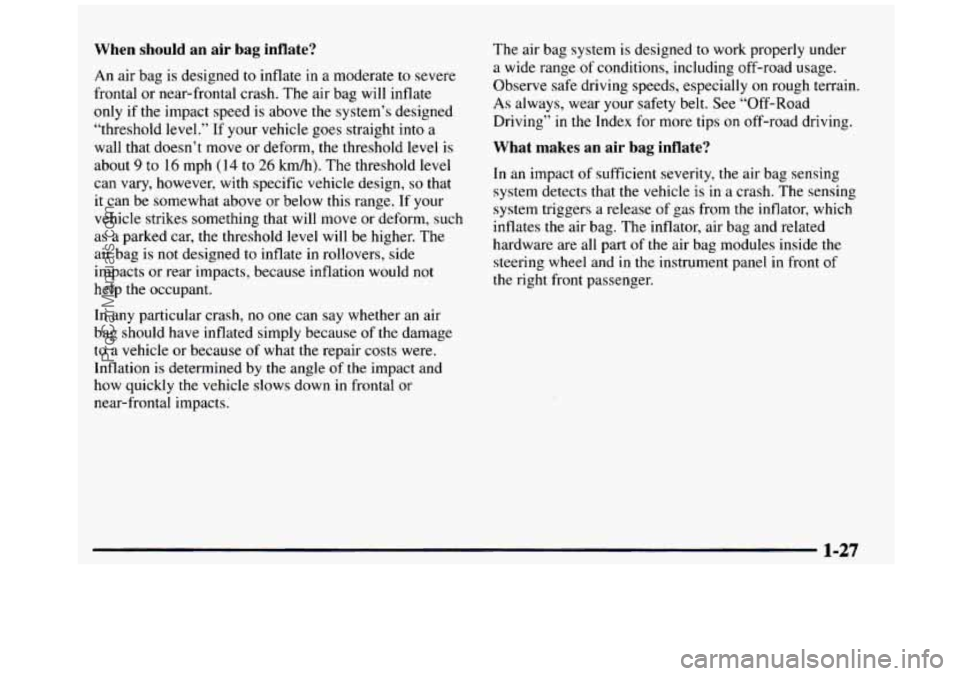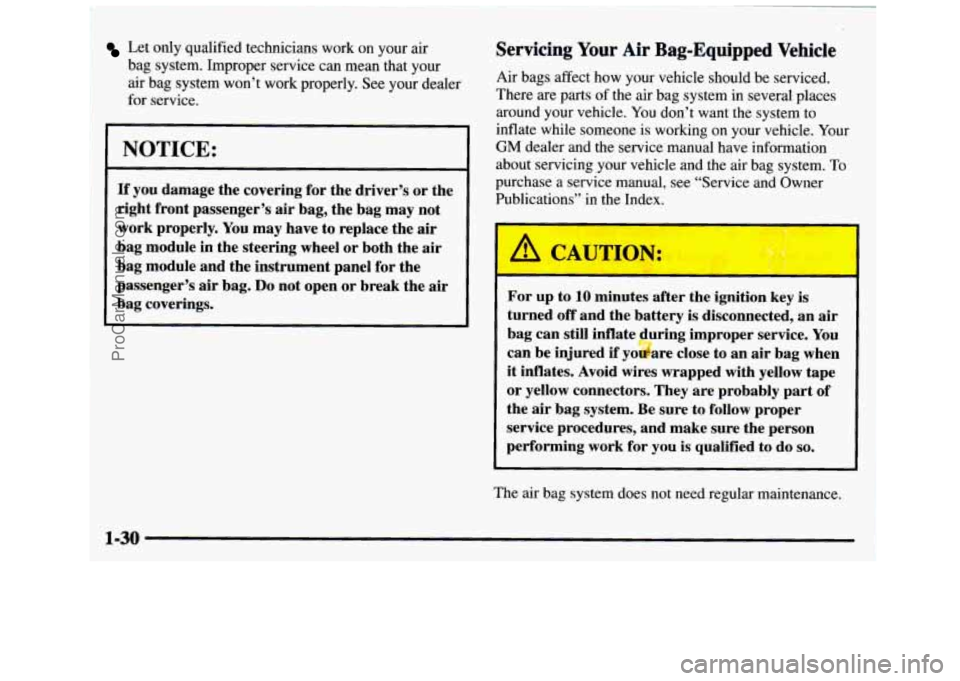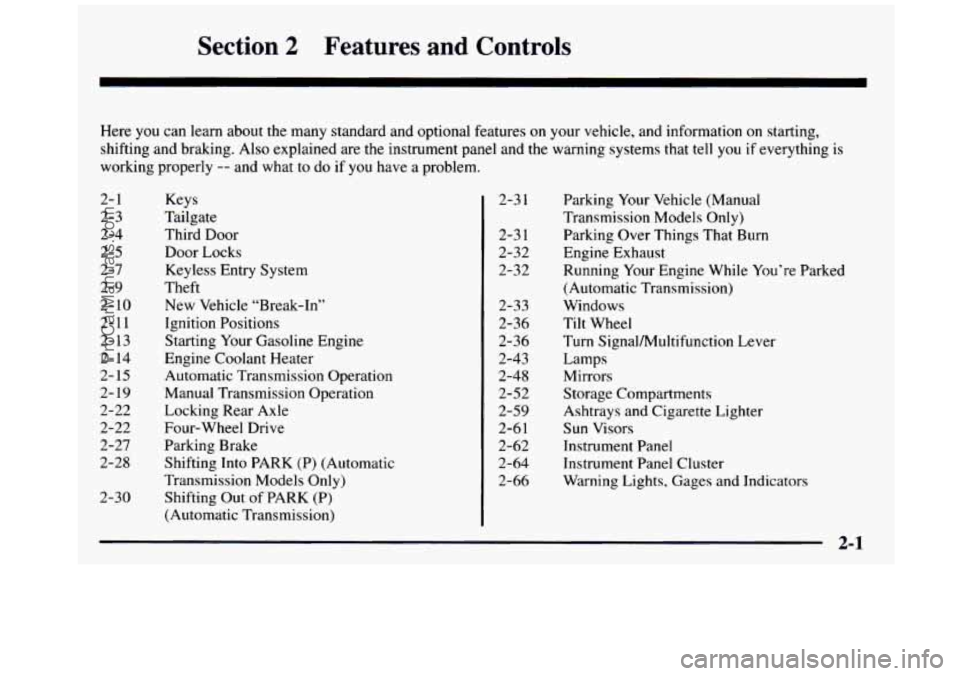Page 19 of 436
Why Safety Belts Work
When you ride in or on anything, you go as fast as
it goes.
Take the simplest vehicle.
Suppose it's just a seat
on wheels.
Put someone on it.
ProCarManuals.com
Page 31 of 436
The best way to protect the fetus is to protect the
mother. When a safety belt is worn properly, it’s more
likely that the fetus won’t be hurt in a crash. For
pregnant women, as for anyone, the key to making
safety belts effective is wearing them properly.
Right Front Passenger Position
The right front passenger’s safety belt works the same
way as the driver’s safety belt. See “Driver Position”
earlier in this section.
Wheri the lap belt is pulled out all the way, it will lock.
(This is the child restraint locking feature working
normally.) If the belt locks, let it
go back all the way
and start again.
Supplemental Inflatable
Restraint System
This part explains the Supplemental Inflatable Restraint
system or air bag system.
Your vehicle may have an
air bag for the driver and
another air bag for the
right front passenger. If
it does, it will say
Supplemental Inflatable
Restraint
on the middle
part of the steering wheel.
1-23
ProCarManuals.com
Page 33 of 436
There is an air bag
readiness light on the
AIR
BAG
instrument panel, which
shows AIR
BAG.
The system checks the air bag electrical system for
malfunctions. The light tells you if there is an electrical
problem. See “Air Bag Readiness Light”
in the Index
for more information.
How the Air Bag System Works
Where are the air bags?
The driver’s air bag is in the middle of the
steering wheel.
ProCarManuals.com
Page 34 of 436
The right front passenger’s air bag is in the instrument
panel on the passenger’s side.
A CAUTION:
If something is between an occupant and an air
bag, the bag might not inflate properly or it
might force the object into that person. The path
of an inflating
air bag must be kept clear. Don’t
put anything between an occupant and an air
bag, and don’t attach or put anything
on the .
steering wheel hub or on or near any other air
bag covering.
1-26
ProCarManuals.com
Page 35 of 436

When should an air bag inflate?
An air bag is designed to inflate in a moderate to severe
frontal or near-frontal crash. The air bag will inflate
only
if the impact speed is above the system’s designed
“threshold level.”
If your vehicle goes straight into a
wall that doesn’t move or deform, the threshold level
is
about 9 to 16 mph (14 to 26 km/h). The threshold level
can vary, however,
with specific vehicle design, so that
it can be somewhat above or below this range. If your
vehicle strikes something that will move or deform, such
as
a parked car, the threshold level will be higher. The
air bag is not designed to inflate in rollovers, side
impacts or rear impacts, because inflation would not
help
the occupant.
In any particular crash, no one can say whether an air
bag should have inflated simply because of the damage
to
a vehicle or because of what the repair costs were.
Inflation
is determined by the angle of the impact and
how quickly the vehicle slows down
in frontal or
near-frontal impacts. The air
bag system
is designed to work properly under
a wide range
of conditions, including off-road usage.
Observe safe driving speeds, especially on rough terrain.
As always, wear your safety belt. See “Off-Road
Driving”
in the Index for more tips on off-road driving.
What makes an air bag inflate?
In an impact of sufficient severity, the air bag sensing
system detects that the vehicle
is in a crash. The sensing
system triggers a release
of gas from the inflator, which
inflates the air bag. The inflator, air bag and related
hardware are all part of the air bag modules inside the
steering wheel and
in the instrument panel in front of
the right front passenger.
ProCarManuals.com
Page 36 of 436

How does an air bag restrain?
In moderate to severe frontal or near-frontal collisions,
even belted occupants can contact the steering wheel
or the instrument panel. Air bags supplement the
protection provided by safety belts. Air bags distribute
the force
of the impact more evenly over the occupant’s
upper body, stopping
the occupant more gradually. But
air bags would not help you in many types of collisions,
including rollovers, rear impacts and side impacts,
primarily because an occupant’s motion
is not toward
those air bags. Air bags should never be regarded
as anything more than a supplement to safety belts,
and then only
in moderate to severe frontal or
near-frontal collisions.
What will you see after an air bag inflates?
After an
air bag inflates, it quickly deflates, so
quickly that some people may not even realize the
air bag inflated. Some components
of the air bag
module
-- the steering wheel hub for the driver’s air bag,
or the instrument panel for the right front passenger’s
bag
-- will be hot for a short time. The parts of the bag
that come into contact with you may be warm, but not
too hot to touch. There will be some smoke and dust
coming from vents in the deflated air bags. Air bag
inflation doesn’t prevent the driver from seeing or from
being able to steer the vehicle, nor does it stop people
from leaving the vehicle.
A CAUTION:
When an air bag inflates, there is dust in the air.
This dust could cause breathing problems for
people with a history
of asthma or other
breathing trouble. To avoid this, everyone in the
vehicle should get
out as soon as it is safe to do so.
If you have breathing problems but can’t get out
of the vehicle after an air bag inflates, then get
fresh air
by opening a window or door.
ProCarManuals.com
Page 38 of 436

, Let only qualified technicians work on your air
I bag system. Improper service can mean that your
air bag system won’t work properly. See your dealer
for service.
NOTICE:
If you damage the covering for the driver’s or the
right front passenger’s
air bag, the bag may not
work properly. You
may have to replace the air
bag module in the steering wheel or both the air
~ bag module and the instrument panel for the
I passenger’s air bag. Do not open or break the air
bag coverings.
Servicing Your Air Bag-Equipped Vehicle
Air bags affect how your vehicle should be serviced.
There are parts of the air bag system in several places
around your vehicle.
You don’t want the system to
inflate while someone is working on your vehicle. Your
GM dealer and the service manual have information
about servicing your vehicle and the air bag system. To
purchase
a service manual, see “Service and Owner
Publications’’ in the Index.
For up to 10 minutes after the ignition key is
turned off and the battery is disconnected, an air
bag can still inflate uring improper service. You
can be injured
if yo 6 are close to an air bag when
it inflates. Avoid wires wrapped with yellow tape
or yellow connectors. They are probably part of
the
air bag system. Be sure to follow proper
service procedures, and make sure the person
performing work for you is qualified to
do so.
The air bag system does not need regular maintenance.
1-30
ProCarManuals.com
Page 75 of 436

Section 2 Features and Controls
-
Here you can learn about the many standard and optional features on your vehicle, and information on starting,
shifting and braking. Also explained
are the instrument panel and the warning systems that tell you if everything is
working properly
-- and what to do if you have a problem.
2- 1
2-3
2-4
2-5
2-7 2-9
2- 10
2-11
2- 13
2- 14
2- 15
2- 19
2-22
2-22
2-27
2-28
2-30
Keys
Tailgate
Third Door
Door Locks
Keyless Entry System
Theft
New Vehicle “Break-In” Ignition Positions
Starting Your Gasoline Engine
Engine Coolant Heater
Automatic Transmission Operation
Manual Transmission Operation
Locking Rear Axle
Four-wheel Drive
Parking Brake
Shifting Into PARK
(P) (Automatic
Transmission Models Only)
Shifting Out
of PARK (P)
(Automatic Transmission) 2-3
1
2-3 1
2-32
2-32
2-33
2-36
2-36
2-43 2-48
2-52
2-59
2-6
1
2-62
2-64 2-66 Parking
Your Vehicle (Manual
Transmission Models Only)
Parking Over Things That Burn
Engine Exhaust
Running Your Engine While You’re Parked
(Automatic Transmission)
Windows
Tilt Wheel
Turn SignalAUultifunction Lever
Lamps
Mirrors Storage Compartments
Ashtrays and Cigarette Lighter
Sun Visors
Instrument Panel
Instrument Panel Cluster
Warning Lights, Gages and Indicators
ProCarManuals.com